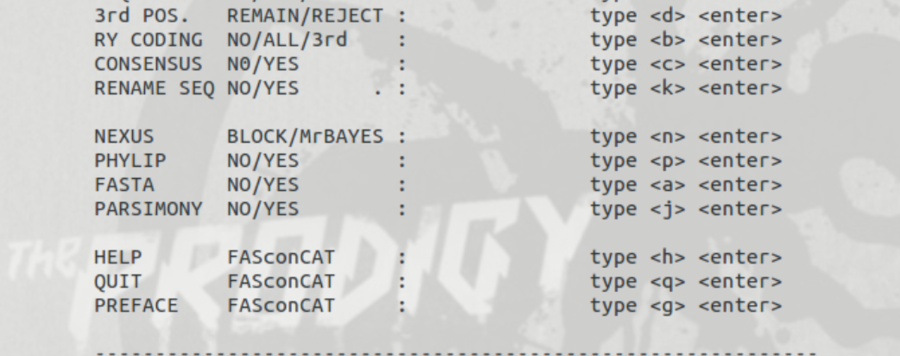Quick facts
Project title:
FASconCAT-G: extensive functions for multiple sequence alignment preparations concerning phylogenetic studies
Description
FASconCAT-G offers a wide range of possibilities to edit and concatenate multiple nucleotide, amino acid, and structure sequence alignment files for phylogenetic and population genetic purposes (Figure) . The main options include sequence renaming, file format conversion, sequence translation, consensus generation of predefined sequence blocks, and RY coding as well as site exclusions in nucleotide sequences and the generation of partitioned files for MrBayes and RAxML analyses. FASconCAT-G implemented process options can be invoked in any combination and performed during a single process run. FASconCAT-G can also read in and handle different file formats (FASTA, CLUSTAL, and PHYLIP) in a single run. It is possible to concatenate nucleotide and amino acid files to one supermatrix file. FASconCAT-G can read sequences in interleaved and non-interleaved format.
The default information output file includes information about concatenated areas of each sequence fragment in the concatenated supermatrix, a list of all concatenated sequences, and several other sequence characteristics. In addition to FASTA format, FASconCAT-G can also output concatenated and/or converted sequence files in NEXUS or PHYLIP format. NEXUS outfiles can be imbedded with MrBayes commands for direct execution in PAUP or output without any specific commands. The default information file also reports base compositions for nucleotide data of single and supermatrix files while an additional info file lists single loop as well as stem pairing positions if structure sequences in dot-bracket format are present. Concatenated and/or single infile structure sequences are printed to this file too.
Simplified flowchart depicting FASconCAT-G implemented options.
Like its predecessor version, FASconCAT, FASconCAT-G is easy to use, very fast (even with large data sets) and not limited in number of input files or input sequences. FASconCAT-G was written on Linux and runs on Windows PCs, Mac OS and Linux operating systems and well suited for the incorporation into automatic process pipelines. The program can be started directly via command line or through interactive menu options. Detailed information and instructions as well as practical examples are provided in the manual of FASconCAT-G.
The actual version of FASconCAT-G and the corresponding manual can be downloaded from GitHub:
https://github.com/PatrickKueck/FASconCAT-G
Location







